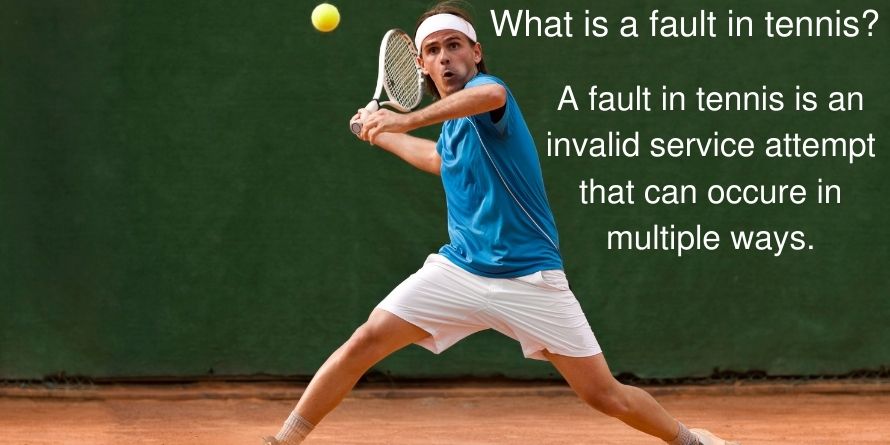In tennis, a fault is defined as an illegal stroke. If you make an illegal stroke during a point, the other player is awarded the point. There are many different types of faults, and it’s important to know what they are and how to avoid them.
In this article, we will discuss the definition of what is a fault in tennis and give some tips on how to avoid making them. In general, in fault tennis definition, A player loses their 1st serve, it’s called a fault. On the other hand, A subsequent loss of their 2nd serve is called a double fault.
You get many serve definitions below in detail, let’s go to read!
What is a Fault in Tennis? The Definition and How to Avoid It
Table of Contents
In tennis fault definition, A fault is a serve that goes “out.” The server tries to start each point by tossing the ball and hitting it diagonally across their court, over the net into the receiver’s service box.
If they land in this area without touching any other part of either side, which would result in points awarded because there are no balls available for play, then you’ve got yourself one good service.
There can only be two opportunities per game though so if both of those turn out as faults then, we’ll see who wins If not? Well, enjoy playing until someone does something really dumb or just doesn’t know what they’re doing yet still manages somehow not to lose.

What Are The Reasons For A Fault In A Tennis Match?
Whenever a server takes an incorrect place when serving, it is normally called “fault”. When their foot mistakenly touches the ground line behind the baseline just between side margins and extensions of the middle zone or court’s extended widths.
A fault has happened, The player cannot touch anywhere before playing ball nor may they jump then take another step forward without jumping again; if done properly this will make sure the receiver knows where your service shall be played since there are restrictions on moving around while throwing balls over fences during singles play, only able to do so while running back, etc.
The server must stand behind the sidelines without touching them until they hit the ball. It is considered illegal if the player touches any boundary line with their feet during play and this can result in penalty points being awarded depending on what type of foot fault it was, crossing over the baseline will incur one point.
While coming up too early would mean losing two; so make sure you don’t commit either. If there’s an open space directly in front of a player, that person may cross over before hitting the ball.
What is a double fault in tennis?
The best way to win points is with a good serve. A fault occurs when you unsuccessfully try putting your service into play in either side’s box; this means it must land on their opponent’s court (service).
You get two tries for every game, so make sure not only do both attempts count but also leave them guessing which one does. During doubles matches servers may not step into the court (unless breaking away from net) when serving or receiving but after catching the serve players are allowed back again as long.

What does fault mean in tennis?
What does fault mean in tennis In A Tennis Match? – Fault – A fault is an unsuccessful serve that does not start the point because of a lack of power with your strokes called Foot Fault.
When you step on or across your baseline before striking, this can result in committing one penalty stroke each time it happens during play. it is also called fault tennis definition
What is the foot fault Penalty?
There’s no penalty for a foot fault – or any other stance violation. The player throws their next shot from wherever they landed, if you have memories that this rule worked differently at some point in the past then it is correct.

What Is A Let In Tennis?
A ball that hits the net cord but still lands in service court is called a let. This means there’s no fault and you can’t repeat your attempt at servicing unless it was an error on behalf of the player or condition.
However, if something happens beyond what we’re able to control like someone else hitting our shot with their racket then re-serve will be allowed under certain circumstances.
How do you call out foot faults in a tennis match?
Foot- Faulting is a common error that players make, but they don’t realize it. The habit can be difficult to break and when you try your serve will become inconsistent because of this change in muscle memory, which actually tries.
In USTA-sanctioned events (and other international competitions), there’s an additional opponent or team official on the court with the umpire who has rights just like him. They may request linesmen intervene during play if any disputed calls happen at baseline; these disputes often arise from whether lobs crossed over into doubles territory.
What are the 7 steps to serve?
- Step 1: The Stance
- Step 2: The Grip
- Step 3: The Hitting Part, were to Lose Drop, Swing Up, and Pronation
- Step 4: Backswing & Toss
- Step 5: Serve in Two Parts
- Step 6: The Power Move
The tennis scoring terms and the tennis points are,
- 0 points= Love
- 1 point = 15
- 2 points= 30
- 3 points= 40
- Tied score= All
- 40-40 = Deuce
- Server wins deuce point = Ad-In
- The receiver wins deuce point = Ad-Out
Ways To Reduce Risks of Foot Fault In Tennis
Faults in tennis are illegal actions that result when a player does not follow certain rules. There can be many types, but some common ones include racket abuse- playing with an inappropriate or excessive amount of power.
Coaching from outside the court (this includes wearing unsuitable clothing); net fraud where someone unmarked onto their opponent’s side makes contact while behind either doubles partner waiting for them at baseline position.
FAQ on Tennis Fault Definition
What are considered faults in tennis?
If your service is missed it is called a fault. The service is a fault if the server misses swinging the ball.
What is the difference between LET and fault in tennis?
It is a service let suggests the ball hit the net successfully and landed in the correct serve box but the server should repeat the serve. However, if the ball hit the net and lands outside the right service box when it is called a fault in tennis.
What is the difference between fault and out in tennis?
Who server misses the ball when it is called it is a fault. But if the server releases the ball but does not hit it so it does not fault then the server may again service attempt so if the ball before bounce hits the net cord, or body racket to the opponent player it is a fault.
What are examples of faults in tennis?
A tennis ball landing outside of the service box is the result of a fault such as a missing serve, illegal release, etc.
Conclusion
Tennis is a game of precision. If you miss your opponent, then they have an opportunity to hit the ball and get it over with as soon as possible. what is a fault in tennis?
There are three types of fault in tennis: foot-fault (also called grounding), serve/returning errors due either because there was not enough power behind what was thrown, or when one side touches the ground before hitting netting for doubles games respectively.
Double faults happen if both sides touch the ground at the same time after ricocheting off anything nearby like walls, etc. A single visit can result in any combination of serving rights depending on how long each party spends reaching.




